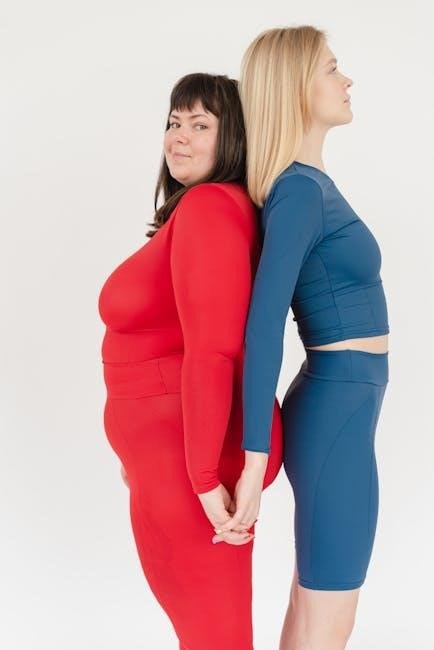A proper panty size ensures comfort‚ confidence‚ and the right fit. This guide helps you understand measurements‚ styles‚ and sizing variations to make informed choices for your body type and preferences.

Why Panty Size Matters
Panty size is crucial for comfort‚ health‚ and confidence. Ill-fitting underwear can cause discomfort‚ skin irritation‚ or restricted blood flow‚ affecting daily activities. Proper sizing prevents issues like digging‚ riding up‚ or lack of support‚ ensuring a smooth‚ seamless fit. It also enhances confidence and reduces wardrobe malfunctions. Accurate sizing is essential for maintaining hygiene and preventing health concerns‚ such as infections or skin chafing. Choosing the right size boosts overall well-being and ensures a comfortable‚ confident you throughout the day.
Common Issues with Incorrect Panty Size
Incorrect panty size can lead to discomfort‚ skin irritation‚ and restricted blood flow. Ill-fitting underwear may cause digging‚ riding up‚ or lack of support‚ disrupting daily activities. Poor fit can also result in wardrobe malfunctions or visible lines‚ affecting confidence. Additionally‚ improper sizing may lead to health concerns‚ such as fungal infections or chafing‚ due to inadequate breathability or moisture retention. Addressing these issues ensures better comfort‚ hygiene‚ and overall well-being. Proper fit is essential for avoiding these common problems and maintaining confidence throughout the day.
Purpose of a Panty Size Guide
A panty size guide is designed to help individuals determine their ideal fit for comfort‚ support‚ and confidence. It provides clear measurements and sizing standards to avoid common issues like digging‚ riding up‚ or lack of support. By understanding waist‚ hip‚ and gusset measurements‚ users can select panties that align with their body type and preferences. The guide also addresses variations across brands and styles‚ ensuring a tailored fit. Its purpose is to empower individuals with the knowledge to choose underwear that enhances comfort‚ hygiene‚ and overall well-being‚ making daily life more enjoyable and stress-free.

Understanding Panty Measurements
Understanding panty measurements involves accurately measuring your waist‚ hips‚ and gusset to ensure the best fit and comfort. This guide helps you master these essential steps.
How to Measure Your Waist
To measure your waist accurately‚ stand upright with feet together and locate the narrowest part‚ typically just above your belly button. Wrap a flexible tape measure around this area‚ ensuring it’s snug but not tight. The tape should be parallel to the floor and not twisted. Exhale normally to avoid compressing the measurement. Record the number to determine your waist size for the panty size chart. This step is crucial for ensuring a comfortable and proper fit‚ especially for styles that sit at the natural waistline.
How to Measure Your Hips
Measuring your hips accurately is essential for determining the right panty size. Stand with your feet hip-width apart and find the fullest part of your hips‚ usually about 7-9 inches below your waistline. Wrap a flexible tape measure around this area‚ ensuring it’s level and not twisted. The tape should be snug but allow for a bit of ease by inserting your finger between the tape and your skin. This measurement is crucial for styles that provide hip coverage‚ ensuring both comfort and a flattering fit. Record this number for accurate sizing.
How to Measure Your Gusset
Measuring the gusset‚ or the crotch depth‚ ensures optimal comfort and fit. Stand upright and place the tape measure horizontally across the crotch area. Start from the front‚ just below the waistband‚ and extend it to the back‚ keeping the tape snug but not tight. This measurement helps determine the length of the gusset‚ ensuring it’s neither too short nor too long. For accuracy‚ wear form-fitting underwear or none at all. Record this measurement to ensure the gusset aligns with your body‚ preventing discomfort or digging. Proper gusset fit is key for all-day wearability.
Common Mistakes in Measuring
When measuring for panty size‚ common errors include not keeping the tape measure level or snug‚ leading to inaccurate results. Many people measure over clothing‚ which can distort the fit. Additionally‚ poor posture‚ such as slouching‚ can affect waist and hip measurements. Forgetting to measure the fullest part of the hips or not aligning the tape correctly can also lead to sizing issues. Ensuring the tape is parallel to the floor and avoiding twisting it is crucial. Taking measurements inconsistently or without proper preparation can result in discomfort and a poor fit.

Panty Size Chart Breakdown
A panty size chart organizes measurements into waist and hip ranges‚ helping you identify your size. It typically includes numeric or alpha sizing for accurate fit selection.
Waist Measurement Ranges
Waist measurement ranges are crucial for determining panty sizes. Typically‚ they start from 26-27 inches (small) up to 34-36 inches (plus sizes). Each range corresponds to a specific size‚ ensuring a comfortable fit. Measure around the narrowest part of your waist‚ just above the belly button‚ with the tape snug but not tight. This ensures accurate sizing and helps prevent issues like digging or riding up. always use a flexible tape measure for precise results.
Hip Measurement Ranges
Hip measurement ranges play a key role in determining panty sizes for a comfortable and flattering fit. Typically‚ hip measurements range from 35-36 inches (small) to 41-43 inches (plus sizes). Measure around the fullest part of your hips‚ about 10 inches below your waist‚ keeping the tape level and snug but not tight. This ensures accuracy and helps avoid issues like digging or riding up. Standing straight and relaxed during measurement is essential for the best results. Proper hip sizing ensures the panty sits comfortably and provides the right support and coverage.
Size Conversion Across Brands
Size conversion across brands can vary significantly‚ making it essential to refer to each brand’s specific size chart. Asian sizes often run smaller than EU/US/UK sizes‚ while some brands offer numeric or alpha sizing. To ensure the best fit‚ always check the detailed measurements provided by the brand. For example‚ a size 6 in one brand might correspond to a size 8 in another. Using the brand’s size guide helps avoid discrepancies and ensures a more accurate fit‚ enhancing comfort and satisfaction with your purchase.
Understanding Numeric vs. Alpha Sizing
Numeric sizing (e.g.‚ 6‚ 8‚ 10) and alpha sizing (e.g.‚ S‚ M‚ L) are two common methods used by brands. Numeric sizes often correlate directly with measurements‚ offering a more precise fit‚ while alpha sizes provide a broader range. For instance‚ a size 8 might align with a medium (M) in some brands. However‚ variations exist across brands‚ so consulting the specific size chart is crucial. Numeric sizing is preferred by those who prioritize exact measurements‚ whereas alpha sizing offers flexibility for different body types and preferences‚ ensuring comfort and a flattering fit.

How to Choose the Right Panty Style
Selecting the right panty style involves considering your body type‚ lifestyle‚ and personal comfort preferences. Different styles cater to various needs‚ ensuring optimal fit and comfort.
Panty Styles for Different Body Types
Panty styles vary to suit diverse body types. For petite frames‚ high-cut or seamless designs provide comfort and a flattering fit. Curvier figures benefit from wide waistbands and supportive cuts. Athletic body types may prefer moisture-wicking fabrics and snug fits‚ while taller individuals might opt for longer leg openings. Understanding your body shape and needs helps in selecting styles that enhance comfort and confidence. Each style is tailored to cater to specific preferences‚ ensuring a seamless and comfortable experience for all body types.
Fabric and Material Considerations
Fabric choice plays a crucial role in comfort and durability. Cotton is ideal for breathability and everyday wear‚ while lace offers a delicate‚ elegant feel. Bamboo fabrics are eco-friendly and moisture-wicking‚ perfect for active lifestyles. Synthetic materials like polyester blend durability with softness. Consider your lifestyle and preferences when selecting fabrics. For instance‚ seamless or hypoallergenic options are great for sensitive skin. High-quality materials ensure longevity and comfort‚ making them worth the investment. Always check care labels to maintain fabric integrity and extend the life of your panties.

Comfort and Support Features
Comfort and support are essential for everyday wear. Look for features like wide waistbands to prevent digging‚ seamless construction to avoid chafing‚ and breathable fabrics for moisture-wicking properties. Padded gusset liners enhance comfort‚ while high-cut legs provide coverage. For active lifestyles‚ consider supportive elastic bands and four-way stretch materials. Some panties feature ergonomic designs to move with your body‚ reducing discomfort during movement; Additionally‚ hypoallergenic materials are ideal for sensitive skin‚ ensuring all-day comfort without irritation. Prioritizing these features ensures a balance of support and relaxation‚ catering to your specific needs and preferences.

Troubleshooting Fit Issues
Identify and address common fit problems like digging‚ riding up‚ or lack of support. Adjust sizing‚ try different styles‚ or materials to resolve discomfort and ensure a better fit.
Common Fit Problems and Solutions
One prevalent issue is panties that dig into the skin‚ causing discomfort. To resolve this‚ opt for a larger size or styles with a softer waistband. Riding up is another common problem‚ which can be addressed by choosing high-cut or seamless designs. If the fit feels too loose‚ consider a smaller size or adjustable waistbands. Ensuring the correct size and style tailored to your body type can significantly enhance comfort and prevent these issues. Regularly updating your size and exploring different fabrics may also provide better solutions.
When to Size Up or Down
If your panties feel restrictive or the waistband digs into your skin‚ it may be time to size up. Conversely‚ if they feel too loose or slide down frequently‚ consider sizing down. Pay attention to how the fabric stretches and whether it allows a full range of motion. If you notice consistent discomfort or gaps‚ reassess your size. Remember‚ body changes over time may require adjustments. Always refer to the specific brand’s size chart‚ as sizing can vary. This ensures a more accurate and comfortable fit tailored to your needs.
How to Avoid Digging or Riding Up
To prevent panties from digging or riding up‚ ensure a snug yet comfortable fit by choosing the correct size. Opt for styles with seamless construction or a high-waisted design‚ which provide better coverage and reduce irritation. Avoid overly tight waistbands‚ as they can cause digging. Instead‚ look for soft‚ breathable fabrics with elastic that retains its shape. Pay attention to the gusset depth and leg openings—properly fitted legs stay in place without rolling or shifting. Regularly updating your size and trying different styles can also help achieve a more secure fit that moves with your body.

Frequently Asked Questions
Common questions include how often to measure‚ if sizes vary by brand‚ and whether bra size relates to panty size. Answers help ensure the best fit and comfort.
Do I Need to Measure Myself for Every Brand?
Yes‚ sizing can differ between brands due to varying fits and materials. Always check the specific size chart for each brand to ensure accuracy. While your measurements remain consistent‚ brands may have unique sizing standards. For instance‚ some brands may run smaller or larger than others. To avoid discomfort or ill-fitting panties‚ refer to each brand’s guide before making a purchase. This simple step ensures you find the perfect fit every time‚ regardless of the brand you choose. Consistency in measurement across brands is key for optimal comfort and style.
How Often Should I Update My Panty Size?
Your panty size may change due to weight fluctuations‚ health changes‚ or natural body shifts over time. It’s recommended to measure yourself every 6-12 months to ensure your size remains accurate. Life events‚ such as pregnancy or significant weight changes‚ may require more frequent updates. Even small changes in body shape can affect fit‚ so regular check-ins are essential. Always use a tape measure to reassess your waist and hip measurements for the best comfort and support. Staying updated ensures you continue enjoying the perfect fit and confidence in your choice of panties.
Can I Use Bra Size to Determine Panty Size?
Bra and panty sizes are not directly related‚ as they measure different body parts. Bra size depends on your bust and band measurements‚ while panty size is based on waist and hip measurements. Using bra size to determine panty size may not provide an accurate fit. For the best results‚ measure your waist and hips separately to find your correct panty size. While some brands offer matching sizes‚ it’s essential to measure both areas independently for comfort and support. Always refer to a panty size chart for precise measurements.

Additional Tips for Different Body Types
Petite: Opt for low-rise styles to elongate your torso. Plus-size: High-waisted panties offer better support and coverage. Curvier: Choose seamless designs to avoid digging. Athletic: Select moisture-wicking fabrics for activity.
Petite Body Type Considerations
Petite women should focus on panty styles that create a balanced silhouette. Low-rise or mid-rise designs can elongate the torso‚ while seamless options avoid adding bulk. Look for slim cuts or boyshorts that complement smaller frames without overwhelming them. Soft‚ breathable fabrics like cotton or bamboo ensure comfort and prevent irritation. Avoid overly decorative details that may draw attention disproportionately. Opt for neutral colors or subtle patterns to maintain a streamlined look. Proper fit is crucial—ensure the waistband sits comfortably above the hip to avoid digging. Petite-friendly brands often offer tailored sizes for a more precise fit.
Plus-Size Body Type Considerations
For plus-size individuals‚ comfort and support are key. Opt for high-waisted styles to provide additional coverage and smooth out curves. Wide waistbands ensure a secure fit without digging into the skin. Seamless or soft‚ stretchy fabrics are ideal for reducing irritation. Avoid overly tight fits‚ as they can cause discomfort or restriction. Look for panty styles with a focus on breathability and moisture-wicking properties to maintain comfort throughout the day. Choose styles that complement your curves‚ such as curve-hugging cuts or shapewear-enhanced designs for added support. Proper fit ensures confidence and all-day wearability.
Athletic vs. Curvier Body Types
Athletic body types often benefit from sleek‚ low-profile panty styles that provide freedom of movement‚ such as thongs or seamless options. These designs minimize visibility under tight clothing while offering comfort during active lifestyles. For curvier body types‚ high-cut or full-coverage styles are ideal‚ as they provide better support and coverage. Wide waistbands are recommended to avoid digging into the skin. Both body types can opt for breathable‚ moisture-wicking fabrics for all-day comfort. Choosing styles tailored to your body shape ensures a flattering fit and enhances confidence‚ whether for everyday wear or athletic activities.

Maintenance and Care
Proper washing and fabric care extend panty lifespan. Avoid tight styles that cause digging and opt for breathable materials. Hand washing and gentle cycles preserve quality and comfort.
How to Wash and Dry Panties for Longevity
To ensure your panties last longer‚ wash them in cold water using a gentle detergent. Avoid fabric softeners‚ as they can reduce breathability. Hand washing is ideal‚ but if using a machine‚ place them in a mesh laundry bag. Gently reshape while damp to maintain fit. Air dry away from direct sunlight to prevent fading and elastic degradation. Avoid high heat from dryers‚ as it can damage materials. Proper care preserves fabric quality and elasticity‚ ensuring comfort and durability.
Importance of Fabric Quality
Fabric quality significantly impacts comfort‚ durability‚ and hygiene. Opt for breathable‚ natural materials like cotton or bamboo‚ which prevent moisture buildup and irritation. Synthetic blends may offer durability but can compromise breathability. High-quality fabrics resist pilling and maintain shape over time‚ ensuring a consistent fit. Soft‚ non-irritating textures reduce chafing and skin discomfort. Investing in premium fabrics enhances comfort‚ supports skin health‚ and prolongs the life of your panties. Always check labels for material composition to make informed choices for your needs and preferences.
Proper panty fit enhances comfort‚ confidence‚ and overall well-being. Always prioritize quality fabrics‚ accurate measurements‚ and styles that suit your body type for the best experience.
Final Tips for Finding Your Perfect Fit
To ensure your perfect fit‚ always measure yourself accurately using a snug tape measure. Consider your body type and activity level when selecting styles. Choose breathable‚ high-quality fabrics for comfort. Don’t hesitate to refer to size charts and read reviews for specific brands. Remember‚ fit preferences can vary‚ so trust your comfort and confidence. Regularly update your measurements and explore different styles to find what works best for you. Proper fit is key to all-day comfort and health.
Importance of Proper Fit for Comfort and Health
A well-fitting panty is essential for daily comfort and overall health. Proper fit prevents discomfort‚ chafing‚ and skin irritation‚ while also reducing the risk of infections. It supports active lifestyles and boosts confidence. Ill-fitting undergarments can lead to health issues like yeast infections or UTIs due to moisture retention or poor airflow. Ensuring a snug yet comfortable fit helps maintain hygiene and prevents bacterial growth. investing in the right size promotes better posture and reduces muscle strain‚ enhancing your overall well-being and quality of life.

